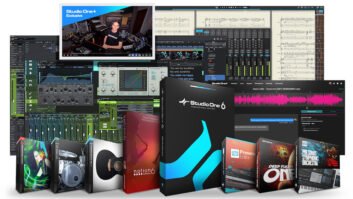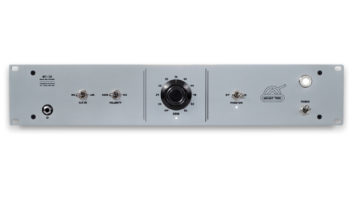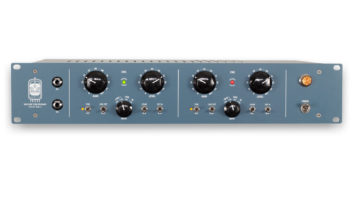

The PreSonus ADL 600 is proof that marriage is a beautiful thing. The dual-channel, all-tube preamp was designed by Anthony DeMaria of boutique tube gear manufacturer Anthony DeMaria Labs and engineered and manufactured by PreSonus. The result is a 2RU mic, instrument and line preamp with a distinctive vintage character, sporting a striking blend of retro and modern cosmetics.
HEY, GOOD LOOKIN’
The ADL 600 features large rotary controls and toggle switches, and both VU and LED metering on its gorgeous front panel. A rotary input control selects among instrument, line and mic inputs for each channel, and mic inputs have a further choice of four different impedance settings to sculpt the signal’s tone. Another rotary switch for each channel selects a 40, 80 or 120Hz highpass filter setting, which is activated by an associated toggle switch. Gain is adjusted for each channel via rotary gain switch and continuously variable rotary trim control. The gain switch provides up to 35 dB of boost in 5dB increments, while the trim control allows a ±10dB gain change, which is useful for fine-tuning or riding gain. Different sensitivities for mic, line and instrument inputs result in varied and eminently useful gain adjustment ranges for each: +18 to +72 dB for mic; -12 to +40 dB for line; and -5 to +42 dB for instrument outputs.
Each channel also sports separate toggle switches to activate regulated +48V phantom power, polarity inversion, -20dB pad and the aforementioned highpass filter. A beautiful blue status indicator lights above each activated toggle switch. A backlit VU meter, 8-segment LED (peak-reading) meter and ¼-inch instrument input phone jack for each channel complete the front panel. The ADL 600’s rear panel offers separate XLR connectors for mic and line inputs and +4dBu nominal line output for each channel.
THE INSIDE STORY
Three tubes (one 12AT7A and two 6922s) serve each channel’s audio path. With the exception of the transformerless instrument inputs, all I/Os are transformer-balanced. The 600V power rails give the ADL 600 an impressive +30dBu headroom for line and instrument inputs, and allow +25dBu maximum input level for padded mic inputs. The maximum output level is specified to be +23 dBu (for 0.5% THD+N). The EIN for mic inputs is a quiet -125 dBu (A-weighted). The unit’s frequency response is stated to be 10 to 45k Hz, ±1 dB.
MAKING TRACKS
When recording electric guitar tracks with a Royer R-122 ribbon mic patched into the ADL 600, I got the most buttery tone and highest gain using the preamp’s highest impedance setting (1,500 ohms). The sound was lush and exhibited a wonderful balance between warmth and smooth presence. Very high frequencies were nicely understated, precluding any glassiness. Setting the ADL 600’s gain switch higher and lowering the trim control enhanced the track’s crunchiness, resulting in an electric guitar timbre to die for. In an A/B test with my Universal Audio 2-610 mic pre (also set to its highest impedance setting), the electric guitar track recorded through the ADL 600 sounded a tad warmer and more compressed (pleasingly so). But on DI’d electric bass, the 2-610 produced a significantly deeper bottom end, while the ADL 600 lent a more forward midrange band.
Next up was a country production, in which the bell-like tones of a DI’d electric guitar were called for. Midrange frequencies sounded most prominent on Strat tracks played through the unit’s instrument input. High frequencies were understated. The overall sound was very lush, but the same guitar played through my Demeter Tube Direct and HV-3D mic preamp produced more scintillating highs and fuller low mids, resulting in a more balanced tone overall. I was also disappointed in the ADL 600’s performance recording a Taylor XXX-MS acoustic guitar in stereo using a spaced pair of B&K 4011 mics. The “twing” of pick strikes was too understated, resulting in a track that lacked detail.
On lead and background vocals (recorded with AKG C 414 B-TLII and Lawson L251 mics), the ADL 600 produced pleasing tube saturation and a soft top end to the tracks. The unit’s highpass filter control helped me sculpt the perfect bottom end. I only wish the ADL 600 produced more top-octave sparkle on the lead vocal tracks.
Patching my 02R’s stereo bus outputs into the ADL 600’s line inputs to process a digital mix, the preamp broadened the mids beautifully, resulting in a warmer, fatter, more analog-like sound. On the downside, the sound was also a little less open, detailed and precise as compared to that of the unprocessed mix. The preamp’s trim controls were useful in balancing the left- and right-channel output levels. In all applications, the unit’s LED meters were slightly difficult to read, as both lit and unlit LED segments sport somewhat pale and related colors that are washed out by the adjacent VU meters’ backlighting.
CONCLUSIONS
Because of its distinctive coloration, the ADL 600 does not flatter in all applications. However, few if any preamps do. Fans of Anthony DeMaria Labs’ tube gear will love the PreSonus ADL 600’s trademark sound, which can most easily be described as vintage-like with lush overtones and a soft top end. The unit sounds awesome on miked electric guitar, and the line inputs warm up edgy or thin tracks beautifully.
Reasonably priced at $2,295 list, the ADL 600 has a unique and interesting tone that will find favor with many tube gear aficionados.
PreSonus Audio Electronics, 225/216-7887, www.presonus.com.

Click here to check out more photos of the ADL 600.
Click here for complete technical specs, hookup diagram, product manual and more!







